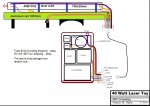Xray_Wombat
New member
- Joined
- May 27, 2019
- Messages
- 2
- Points
- 1
well...
worth resurrecting that topic for some art. A few light weight brass appointments, a 70 year old mA meter for tube current, and a little gothic touch here and there and you got a nice steampunk laser. Very authentic 80 Lb backpack as well.. but why skimp on batteries or go for short-duty stuff? Might get 2 hours of beam time from a 100AH 12V AGM. Coolant temp could become an issue as most of those tubes want 20-25 deg water.. chiller's not practical to carry. Palte cooled thermoelectric maybe but still it's a 400W heat load!

worth resurrecting that topic for some art. A few light weight brass appointments, a 70 year old mA meter for tube current, and a little gothic touch here and there and you got a nice steampunk laser. Very authentic 80 Lb backpack as well.. but why skimp on batteries or go for short-duty stuff? Might get 2 hours of beam time from a 100AH 12V AGM. Coolant temp could become an issue as most of those tubes want 20-25 deg water.. chiller's not practical to carry. Palte cooled thermoelectric maybe but still it's a 400W heat load!

Last edited:



